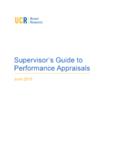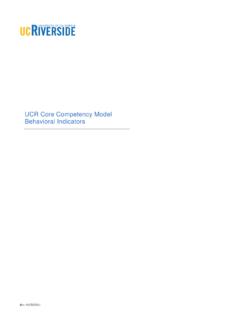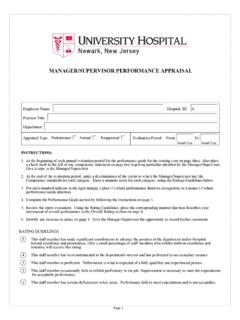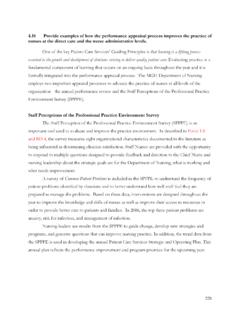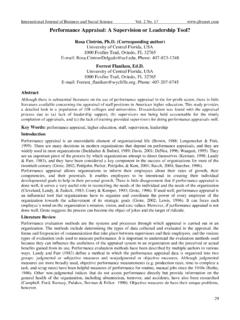Transcription of Supervisor’s Guide to Performance Appraisals
1 supervisor s Guide to Performance Appraisals June 2015 Table of Contents Content Overview .. 1 The UCR Performance Management Process .. 1 Planning for Performance .. 2 Key Elements in the Planning Process .. 2 Key Steps in the Planning Process .. 2 Planning for Performance Setting Expectations and Goals .. 3 Setting Expectations .. 3 Setting Goals .. 4 Managing and Coaching Performance .. 5 Observation .. 5 5 Appraising Performance .. 6 The Performance Appraisal Process .. 6 Appraising Poor Performance .. 6 Writing the Appraisal .. 7 Appraisal 8 Creating Development Plans.
2 9 Creating Individual Development Plans .. 9 Purpose of the Individual Development Plan .. 9 Developing the Individual Development Plan .. 9 Developmental Activities .. 10 Conducting the Performance Appraisal Meeting .. 11 Setting the Tone .. 11 Structure of the Meeting .. 11 Performance Management Frequently Asked Questions .. 13 Suggested Readings .. 15 1 Content Overview The topics covered in the material include: A review of the UCR Performance management process. How to develop Performance expectations and goals. Translating subjective assessments into objective terms.
3 Writing Performance Appraisals using objective, behavioral descriptions. Conducting a structured Performance appraisal meeting. The goal of the UCR Performance appraisal process is two-fold: development and collaboration. While we all associate Performance Appraisals with evaluation, an often overlooked aspect is the developmental piece. This is an opportunity for you and your employees to focus on their development. In addition, it should be a collaborative process. It is not you, as the supervisor , giving a report card to your employee, but an interactive exchange about the employee s Performance .
4 The UCR Performance Management Process The four major components of the Performance management process are Planning, which includes setting expectations and goals and defining job responsibilities; Managing and Coaching Performance throughout the year; Appraising Performance ; and Recognizing and Rewarding Performance . It is a continuous cycle, not just a once a year event, with feedback linking each part of the process. Appraise Set Define Job Responsibilities Manage/Coach Planning 2 Planning for Performance Key Elements in the Planning Process Understand the mission of UCR and your organization.
5 Understand your organization s values and goals. Link individual expectations to the organization s mission, values and goals. Key Steps in the Planning Process 1. Ensure that the position description is current. A review of the position description should be done every year. If duties in the position have changed that do not warrant a reclassification, revisions should be made and forwarded to the Human Resources Department as an Updated Position Description. The employee should also review their position description and be prepared to provide you with feedback regarding changes.
6 2. Identify the essential job functions. This refers to the duties that must be carried out by the position basically the reason the position exists. Have the essential functions changed? Do some need to be added? These essential functions can be used as a Guide to setting Performance expectations. 3. Develop Performance expectations. 4. Develop goals and objectives. 5. Identify applicable Performance factors. The UCR Performance appraisal form includes seven Performance factors and the option to include other Performance factors not listed. It should be determined which factors are applicable to the position being appraised and those that need to be added.
7 3 Planning for Performance Setting Expectations and Goals Understanding the mission and goals of the University and your organization provides a context in which to develop Performance standards and goals. It gives you a framework and a direction. Of primary importance, is the employee s ability to see how their Performance expectations and goals are linked to the mission of the department. Setting Expectations What is a Performance Expectation? A description of the results expected for the fully satisfied Performance of a job function/task. Defines how well each function or task must be performed.
8 Provides a benchmark against which to evaluate work Performance . When Should Performance Expectations be Set? When an employee is hired When responsibilities are changed or added When clarification of responsibilities is needed A Performance expectation should be: Derived from mission, goals and values Mutually understood Developed collaboratively, if appropriate Descriptive of how a job is to be performed Descriptive of fully satisfactory Performance Expressed in measurable/observable terms Reasonable and attainable 4 Setting Goals In setting goals, use the formula.
9 Specific precise terms Targeted Measurable Means for tracking How much of what & by when Attainable Assess the stretch Evaluate the growth for the employee Relevant Links to results Links to higher-level goals (dept.) Trackable Timeframe for actions Completion dates In Performance planning, there are typically three types of goals that may be incorporated into the review: Development goals goals established for personal/professional growth Innovation goals goals established for creating a new process, function or program; higher level of service Improvement goals goals established to correct Performance that is below standards and requirements.
10 Goals should be defined when: preparing the annual Performance appraisal Performance needs improvement 5 Managing and Coaching Performance Performance management is a year round process which means meetings should be held with employees throughout the year to discuss and reassess the employees progress toward achieving goals and Performance objectives. Listed below are some of the tools that can be used to capture Performance . Observation It is recommended that managers observe their employees with the intent of documenting behaviors related to Performance .
